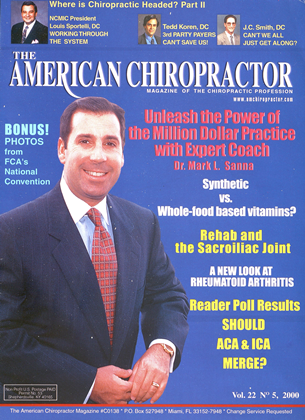This year, experts predict that cancer will surpass heart disease as the number one killer of Americans today. According to the American Cancer Society, almost five million lives have been lost to cancer since 1990. In the year 2000, over one million new cancer cases are expected to be diagnosed. As you may recall, in an earlier article for TAC (Vol. 22, I. 4), I focused on the need for health score-cards and the vital role they can play in your practice of preventative medicine. Rather than diagnosing disease or addressing symptoms, the tests used to formulate this scorecard should pinpoint exactly where an individual falls on the scale of risk for various diseases, thereby providing current baseline measurements. A chiro- praetor that implements such a system of measurements, will find it much easier to motivate patients to follow certain health guidelines and to work toward reducing their health risks. One of the most important tests that should be used to determine a patient's health score could save him/her from a premature death caused by cancer. Breakthroughs in science have shown a link between cancer and dangerous molecules called free radicals. Over 85 other diseases, including atherosclerosis, stroke, cataracts, and Alzheimer's have also been linked to free radical damage. In addition, free radicals have been tied to joint pain, shortness of breath, eye strain, excess bruising, and age spots.1 These highly reactive molecules, created by environmental toxins, electronic devices, sunlight, pesticides, and chemicals, are oxygen molecules that are missing an electron. Free radicals "attack" the stable, healthy cells of the body, looking for their missing electron. According to some experts, the cells of our body are subjected to over 10,000 hits from free radicals every day.2 As the cells are bombarded and the cell lining becomes weak, oxidation takes place, allowing disease to set in and leading to premature aging. Fortunately, these cell-attacking molecules can be kept in check by utilizing the power of antioxidants. Antioxidants can stop the harmful oxidation process and can even repair damage that has already been caused by free radicals.3 While the body does produce some antioxidants, the prevalence of environmental toxins has created an ever-increasing number of free radicals. This bombardment overtaxes the body's natural ability to combat the oxidation process. For this reason, it has become necessary to supplement with antioxidant nutrients. The benefits of implementing an antioxidant formula into your practice .1 preventative medicine are invaluable. As more and more companies begin jumping on the antioxidant bandwagon, however, it .has become increasingly more difficult to determine which antioxidant formulas are effective, and which are not. Many companies have proclaimed the virtues of one nutrient or another, but effective antioxidant protection requires a many-pronged approach. In order to determine which patients have the greatest need for antioxidant supplementation, there must be a test to discover the level of free radicals present in the body. Now, thanks to advanced technology, tests of this kind are readily available! One such test, called the OxiData™ Test, was developed at Loma Linda University. This test is extremely easy to conduct and requires no lab work. Thus, instead of waiting several hours or days for results, a patient can learn his or her free radical levels within only five minutes. The (JxiData™ lest measures the distant end of the polyunsaturated fat chain where aldehydes form as a result of free radical attacks. This measurement is discovered by obtaining a col-orometric (color absorbent) reading from a urine specimen. Using a urine test has been shown to be fifty times more sensitive than blood/plasma aldehyde testing. This point-of-care test means the need for antioxidant protection no longer has to be explained in words alone. Instead, the results of the OxiData Test, and others like it, now show just how important it is for you and your patients to protect yourselves from the ravages of free radicals. Continued on Page 47 PREVENTION ...from page 44 In the typical health care scenario, a patient waits until he or she is feeling ill before seeking out medical care. Many times, the diagnosis ends up being far worse than they had expected. Being told you have cancer, for example, is no easy pill to swallow. Fortunately, however, the majority of diseases, such as cancer, can be prevented if people are aware of their risks and take the actions necessary to prevent disease. With procedures such as the OxiData™ Test, the technology is now available to provide patients with this life-saving information. Consider how effective such a test could be in your efforts to teach prevention and motivate patients to improve their health before serious diseases set in. In your desire to create a more wholistic approach toward health, don't forget the vital part free radical testing should play in your practice. New technology enables people of all ages to determine the level of stress on their bodies caused by free radical activity. We can all benefit from knowing if we are getting enough antioxidants in our diets and nutritional supplements to counteract free radical damage. Thanks to years of research, we are now able to determine the need for these vital free radical fighting nutrients-before its too late! Doug Grant is a degreed nutritionist with a sports medicine background, who serves as a nutritionist with many teams from the NBA and has trained thousands of doctors around the world. Doug also serves as a member of the Board of Trustees of one of only three accredited naturo-pathic medical colleges in the United States. To obtain a complimentary OxiData™ Test to determine your free radical levels, call Optimal Health Systems at (800) 890-4547. References 1. Newmark, Gretchen Rose, M.A., R.D. and James M. Gerber, M.S., D.C. "Antioxidants: Key to a Healthier Life," Let's Live, Nov. 1992. 2. Gorner, Peter and Ronald Kotulak. "Scientists try to tame molecular "sharks."' Chicago Tribune, 12/11/91, Front page. 3. Reuben, Carolyn. Antioxidants: Your Complete Guide. Rocklin, CA: Prima Publishing,
 View Full Issue
View Full Issue






